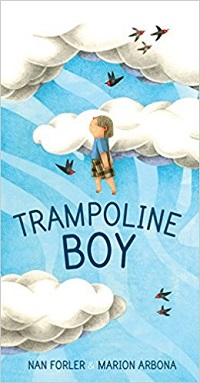| ________________
CM . . . . Volume XXIV Number 18. . . . January 12, 2017
excerpt:
Trampoline Boy likes to bounce on the trampoline (in his backyard?); he will bounce all day, every day, regardless of the taunts and comments of other children who pass by (“What's the matter with you anyway?” “He is so weird.”). One of the other children, called Peaches, takes an interest in Trampoline Boy and starts to wonder what things look like to him as he bounces “up there in that blue, blue sky.” She quietly waits until he approaches her, and they become friends who bounce on the trampoline together. Trampoline Boy can be read and used in several ways. With its simple language and direct narrative, it could be read to a younger child as a straight up friendship story like Ruth Ohi's Fox and Squirrel series or Chris Raschka's Yo! Yes?. Because of Trampoline Boy's obsession with bouncing and subsequent ostracization, it could be used to start a discussion with a slightly older child about being different and accepting differences. Depending on how you interpret the depiction of earth (mainly red, strong contrasting boundaries and straight lines), sky (mainly blue, softer boundaries and wavy, curving lines), and the way the world fades out around Peaches and Trampoline Boy as they begin to bounce, it could also become a book about the power of imagination and the pleasure of shared imagination. Readers may have questions about why Trampoline Boy is called weird, though. Wanting to bounce on a trampoline all day is not usually, in itself, odd enough to attract the mean comments of the children passing by his yard. Although there is no reference or context in the book itself and the publisher's website only mentions “different perspectives”, the promotional material that came with the review copy mentioned that this was a book about being on the autism spectrum. Knowing this fills in some of the gaps in the narrative and helps to put the story in context, but it is not really necessary for the other ways of reading listed above. As such, it would be limiting to say that this is solely or mainly a book about autism, but it would certainly be a wonderful inclusive book for families and classrooms with siblings or classmates on the autism spectrum. The creamy colored gouache and pencil art has an attractive textured quality that makes you want to touch it, and, although the narrow format of the book (possibly to emphasize the up and down movement on the trampoline) may feel a little cramped, the pictures are focused enough and the amount of text is appropriate for a storytime read-aloud with a medium sized group. Trampoline Boy and Peaches are white and dark haired; the mean children are a multicolored and multiracial group. Highly Recommended. Saeyong Kim has an MA in Children’s Literature and an MLIS; she lives in British Columbia, where she works as an auxiliary public librarian.
Next Review |
Table of Contents for This Issue
- January 12, 2018. |
